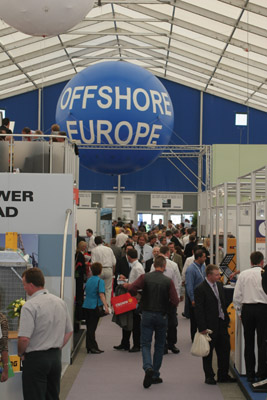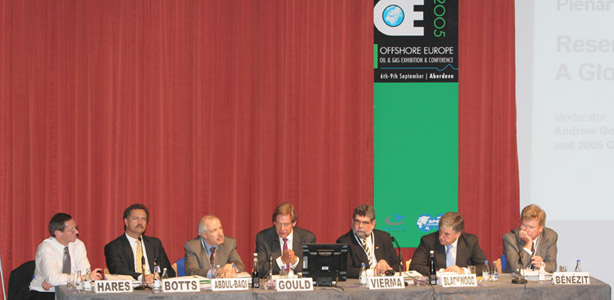How to
manage mature production provinces, both globally and in the
North Sea, while meeting rising hydrocarbon demand framed
discussion at the 2005 Offshore Europe Oil and Gas Exhibition
and Conference in Aberdeen. Attendance at the biennial event,
held 6–9 September, surpassed 30,000, breaking the previous
attendance record of 26,337 in 2003.The conference
offered a strong plenary and technical program, evident in the
opening general session—titled “Reserves Recovery and Decline: A
Global Perspective”—that featured a global who’s who in the oil
and gas industry. Leading off the session was Andrew Gould,
Chairman and Chief Executive Officer of Schlumberger, who also
chaired this year’s Offshore Europe conference. Gould contends
that the world has enjoyed a false sense of energy security
because of the excess oil production in the late 1980s and the
1990s. “Today, rapid demand growth due to the emergence of China
and India and a lack of investment in an aging production base
and refining system have led to very little security of supply
of crude oil, natural gas, and refined products,” he said.

The exhibition featured 1,661 companies.

Panelists at the opening general session included, from left,
Nigel Hares, Executive Vice President, Frontier and
International Operations, Talisman Energy;
Tom
Botts,
Executive Vice President-Europe,
Shell
Intl. E&P; Mahmoud Abdul-Baqi, Vice President Exploration, Saudi
Aramco; Andrew Gould, Chairman and CEO, Schlumberger; Luis
Vierma, Vice President E&P, PDVSA; Dave Blackwood, Director and
Business Unit Leader–Developing Assets Business Unit, BP; and
Michel Benezit, Vice President Northern Europe, Total.
Gould agreed with other panelists in the opening plenary
that hydrocarbons will be the fuel of choice for perhaps decades
to come, but that development and production have entered a new
phase. “Reserves are large but finite, operations in new areas
are becoming even more technically complex, and nonconventional
hydrocarbons will form a larger part of the production base” in
the future, he said. Principally, production decline rates in
mature basins are growing in significance. “We are moving into a
period where the bulk of new developments will either be in deep
water or harsh Arctic conditions, or in the hands of national
oil companies,” he said. “Technology will continue to emerge for
finding and development; however, we will also see a huge
increase in technology developed to increase production from
mature fields and, therefore, prolong the production plateau or
slow the rate of decline.”
Mahmoud Abdul-Baqi, Vice President of Exploration for
Saudi Aramco, outlined the challenges facing the industry as it
strives to develop additional reserves to meet global
consumption. “The main challenge is to commit the capital to
develop reserves,” he said, and that investment needs to be made
now. Regarding technology, greater emphasis should be placed on
tools that expand the reserves base and drive down the cost of
development. Producers need technology that promotes more
accurate imaging of reservoirs, enhances automated field
surveillance, and allows for faster drilling, Abdul-Baqi said.
“There is no real physical shortage of oil,” Abdul-Baqi
said, contradicting proponents of the “peak oil” argument. In
particular, he said, large areas of Saudi Arabia are unexplored,
and the country’s exploration program is expanding. In addition,
the kingdom will continue to maintain spare production capacity
of 1–2 million BOPD. The robust outlook for oil and gas will
create numerous opportunities for young professionals, who
should be recruited by the industry aggressively, he said.
An officer of another national oil company and OPEC member
offered an upbeat assessment of the industry tinged with caution
as well. Luis Vierma, Vice President of E&P for PDVSA, the
national oil company of Venezuela, said exploitation of
extra-heavy crude oil reserves could make that country the
largest producer of hydrocarbons. Venezuela has approximately 77
billion bbl of proven conventional oil reserves and another 270
billion bbl of extra-heavy and bitumen deposits. In addition to
focusing on new production, the industry must also take a look
at global refinery capacity that will be needed to turn that oil
into consumer products such as gasoline, he said. Product demand
may soon outstrip refinery capacity, and it takes years to build
a new refinery.
Tom
Botts,
Executive Vice President-Europe for
Shell
Intl. E&P, also noted the increasing importance of downstream
elements in upstream operations. More resources are being found
that are unconventional and require downstream processes to turn
those resources into synthetic oil, he said. “We have to be
prepared to blur the traditional upstream/downstream split,” he
added. Despite declining production in the North Sea,
Botts
said he was optimistic that technology would prolong the
region’s potential. “Our industry has a good track record of
outperforming expectations in the North Sea,” he said.
Offering an independent’s perspective, Nigel Hares,
Executive Vice President, Frontier and Intl. Operations for
Talisman Energy, called attention to the growing importance of
independent operators in the North Sea. The Canadian company has
become one of the leading operators in the region. Big companies
should handle big projects, and smaller companies should deal
with smaller projects, he said. That is what is happening in the
North Sea and in other provinces globally—as a basin matures,
the opportunities drop, and smaller companies take on a greater
role.
At the close of the opening plenary, U.K. Energy Minister
Malcolm Wicks announced the results of the latest North Sea
bidding round. The government awarded the greatest number of
exploration licenses (152 covering 264 blocks) in U.K. history,
including 24 new entrants to the region. That proves that the
North Sea, despite declining output, is being revitalized as new
technologies and government policies combine to make the area
attractive to investment. ExxonMobil received 1.2 million acres,
the largest single license award in U.K. history. Those 20
contiguous blocks are in the relatively unexplored Mid-North Sea
High area.
Shell
owns a quarter of the joint venture.
In a separate plenary, titled “Delaying the Production
Peak,” Robert C. Olsen, Chairman and Production Director for
ExxonMobil Intl., laid out the future supply/demand balance and
the importance of technology in that scenario. World oil and gas
production is currently declining between 4 and 6% each year.
That decline, combined with demand growth, means that the amount
of new production needed by 2030 will exceed today’s total
production, he said. Approximately 60% of the energy supply in
2030 will come from oil and gas.
The industry generally underestimates its ability through
technology to lower costs and increase production, Olsen said.
But if recovery efficiency is increased by only 1%, that would
equate to 80 billion additional barrels of conventional oil, or
more than 2 years’ worth of production at today’s rate. “Our
challenge is not the availability of oil and gas resources—they
are available,” he said. “Our challenge is development: Ensuring
that we have access to the resources, stable fiscal terms, and
effective technology so that we can efficiently develop these
resources while minimizing our impact on the environment.”
Many in industry and government estimate that North Sea
production to date—approximately 34 billion BOE—is only half of
its potential. The region is a high-cost area in which to
operate and will have to compete with other basins around the
world. Developing the North Sea’s potential “will be more
difficult and more expensive on a unit basis,” Olsen said. The
industry must leverage the value of existing infrastructure,
governments must foster a favorable business climate, and the
right technologies will have to be deployed, he said.
Several technologies in particular have dramatically added
to the world’s oil and gas reserves over the past 25 years and
will continue to play a key role in future development,
according to Olsen.
-
Improved seismic has greatly enhanced the
dry-hole/discovery ratio and helped recovery in mature
basins.
-
State-of-the-art visualization centers are allowing
geoscientists and engineers to work together to optimize
development plans.
-
Improved reservoir and geological modeling have
improved the chances of determining the best well
locations and well designs to maximize recovery.
-
Advances in directional drilling have enabled the
industry to hit reserves with great accuracy.
Extended-reach drilling is playing a critical role, for
example, in ExxonMobil’s Sakhalin 1 oil and gas
project.
-
Deepwater-development advances are bringing on line
several new production provinces.
-
Liquefied-natural-gas technology is rapidly changing
the landscape, with gas markets now becoming global in
nature.
Offshore Europe also hit a record for number of
exhibitors. The 1,661 exhibiting companies, included operators,
service companies and national oil companies. In all, 107
countries were represented at the show either as exhibitors or
visitors.
Click here to return to
ShellNews.net HOME PAGE

